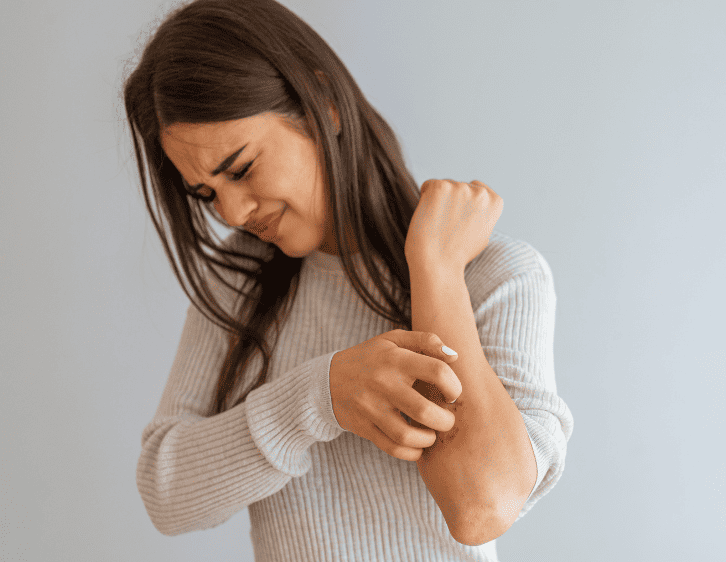Recognizing the typical manifestations and patterns of psoriasis is an important step in getting a handle on the condition. Millions of individuals throughout the world suffer from psoriasis, a chronic skin disorder with a wide range of symptoms. Here, we’ll explore the unique characteristics of psoriasis, providing in-depth information about the condition’s signs, patterns, and treatment options.
What is Psoriasis?
Psoriasis is a non-contagious skin disorder that results from the immune system mistakenly attacking healthy skin cells. This leads to the rapid growth of skin cells, causing them to pile up on the surface of the skin, creating patches or plaques. Psoriasis can manifest in various forms, and its symptoms can range from mild to severe. Understanding the different types of psoriasis is crucial to recognize its common symptoms and patterns.
Types of Psoriasis
- Plaque Psoriasis: This is the most common form of psoriasis, characterized by raised, red, and inflamed patches covered with silvery-white scales.
- Guttate Psoriasis: This type often begins in childhood and is marked by small, drop-shaped sores on the skin.
- Pustular Psoriasis: This less common type results in pus-filled blisters surrounded by red skin. It can be localized or affect large areas.
- Inverse Psoriasis: Found in skin folds, such as under the breasts or in the armpits, it appears as smooth, red patches.
- Erythrodermic Psoriasis: This is a rare but severe form of psoriasis that can cover the entire body with a fiery red rash.
Common Symptoms of Psoriasis
One of the hallmark symptoms of psoriasis is the presence of red and inflamed skin. These areas of irritation can be widespread or localized and are characterized by their distinctive red hue, which sets them apart from normal skin. Accompanying this redness, psoriasis frequently brings about silvery-white scales. These scales, often compared to flakiness, result from the rapid turnover of skin cells, a process gone awry in psoriasis. The presence of these scales can be not only uncomfortable but also aesthetically concerning for those with psoriasis.
Another notable symptom is itching and discomfort. Many individuals with psoriasis experience itching, which can vary in intensity from mild to severe. This itching can be a constant source of irritation and distraction, making daily life challenging for those living with the condition. Additionally, psoriasis often leads to dry and cracked skin. This dryness can result in painful fissures in the skin, and in severe cases, these fissures can even bleed. This combination of symptoms can be physically and emotionally taxing for individuals dealing with psoriasis.
Furthermore, nail changes are a common occurrence in psoriasis. These changes can involve pitting, where small dents or depressions appear on the surface of the nails. Discoloration of the nails is also common, with yellowish or brownish spots often forming. In some instances, nail psoriasis can be severe enough to cause the nail to separate from the nail bed, leading to a condition known as onycholysis. This not only affects the appearance of the nails but can also cause discomfort.
In some cases, individuals with psoriasis may experience joint pain, a symptom associated with a condition known as psoriatic arthritis. This type of arthritis can affect the joints, leading to swelling, pain, and stiffness. The combination of skin and joint symptoms can significantly impact the quality of life of those affected.
Recognizing Patterns in Psoriasis
Understanding the patterns of psoriasis is essential for proper management. Here are some common patterns that individuals may observe:
- Symmetrical Presentation: Psoriasis often appears on both sides of the body in a symmetrical fashion. For example, if you have a patch on your left elbow, you’re likely to have a similar patch on your right elbow.
- The Koebner Phenomenon: This phenomenon occurs when psoriasis develops at the site of skin injury or trauma. Even a minor scratch or sunburn can trigger a psoriatic lesion.
- Scalp Involvement: Scalp psoriasis can manifest as red, scaly patches on the scalp, often extending beyond the hairline. It can lead to itching and flaking.
- Nail Psoriasis: Nail changes, such as pitting or discoloration, are common in individuals with psoriasis. This pattern can be indicative of psoriatic involvement.
Management and Treatment
Psoriasis, a chronic and often challenging skin condition, lacks a definitive cure, but there are t available to manage its symptoms and enhance the quality of life for those affected. These treatment strategies are tailored to the specific needs and severity of the condition.
Topical Treatments
For many individuals with psoriasis, topical treatments are the first line of defense. These treatments come in the form of creams, ointments, and shampoos, which are applied directly to the affected skin or scalp. They work by reducing inflammation and scaling, helping to alleviate the redness and discomfort commonly associated with psoriasis. Topical corticosteroids, vitamin D analogs, and retinoids are among the options available.
Phototherapy
Another valuable treatment option is phototherapy, which involves exposing the skin to controlled amounts of ultraviolet (UV) light. UV light can slow down the excessive growth of skin cells that characterizes psoriasis. There are two primary types of phototherapy: UVB (narrowband and broadband) and PUVA (Psoralen plus UVA). Phototherapy is typically administered under medical supervision to ensure safety and effectiveness.
Oral Medications and Biologics
In severe cases of psoriasis or when topical treatments and phototherapy are insufficient, healthcare providers may turn to oral medications or biologics. These options are reserved for more extensive and debilitating forms of the condition. Oral medications can include methotrexate, cyclosporine, and acitretin. Biologics, on the other hand, are a class of medications that target specific proteins in the immune system to suppress the autoimmune response responsible for psoriasis. Skyrizi is one such biologic, known for its efficacy in treating moderate to severe psoriasis. It works by targeting the interleukin-23 (IL-23) pathway, a key player in the development of psoriatic plaques. Skyrizi injections are administered under the guidance of healthcare professionals and have shown promising results in managing psoriasis symptoms.
Lifestyle and Home Remedies
In addition to medical treatments, managing psoriasis effectively often requires lifestyle adjustments and home remedies. Stress management is crucial, as stress can exacerbate psoriasis symptoms. Engaging in relaxation techniques, exercise, and maintaining a healthy diet can all contribute to overall well-being. Furthermore, regular use of moisturizers can help alleviate dry and cracked skin, a common symptom of psoriasis.
While psoriasis remains an incurable condition, numerous treatment options are available to manage its symptoms and provide relief to those affected. The choice of treatment depends on the severity of the condition and individual factors, and it often involves a combination of medical interventions, lifestyle modifications, and, in some cases, biologic medications like Skyrizi, which have shown significant promise in improving the lives of individuals with moderate to severe psoriasis. Consulting with a healthcare professional is essential to determine the most suitable treatment plan for each individual.
For inquiries about our products please call us or send us a message on our Chat box. You can also send us a message on our Facebook page.


















